Table of Contents
- Introduction
- Editor’s Choice
- Game-based Learning Market Statistics
- User Preferences in Game-based Learning Statistics
- Growth Rate of Educational-type Games
- Game-based Learning in Education Statistics
- Work Setting Game-based Learning Statistics
- Benefits of Using Digital Games Within Learning
- Recent Developments
- Conclusion
- FAQs
Introduction
Game-based Learning Statistics: Game-based learning uses gaming principles to make education engaging and motivating.
It involves using games, whether digital or analog, to encourage active learning, provide instant feedback, and promote problem-solving and critical thinking skills.
Games cover a wide range of subjects and skills, from math to soft skills like teamwork. They can be adapted to individual skill levels and foster collaboration among learners.
However, using them judiciously and aligning them with specific learning goals while ensuring they complement other teaching methods is essential.
Ultimately, game-based learning adds an element of fun to education, making it more enjoyable and effective for learners.
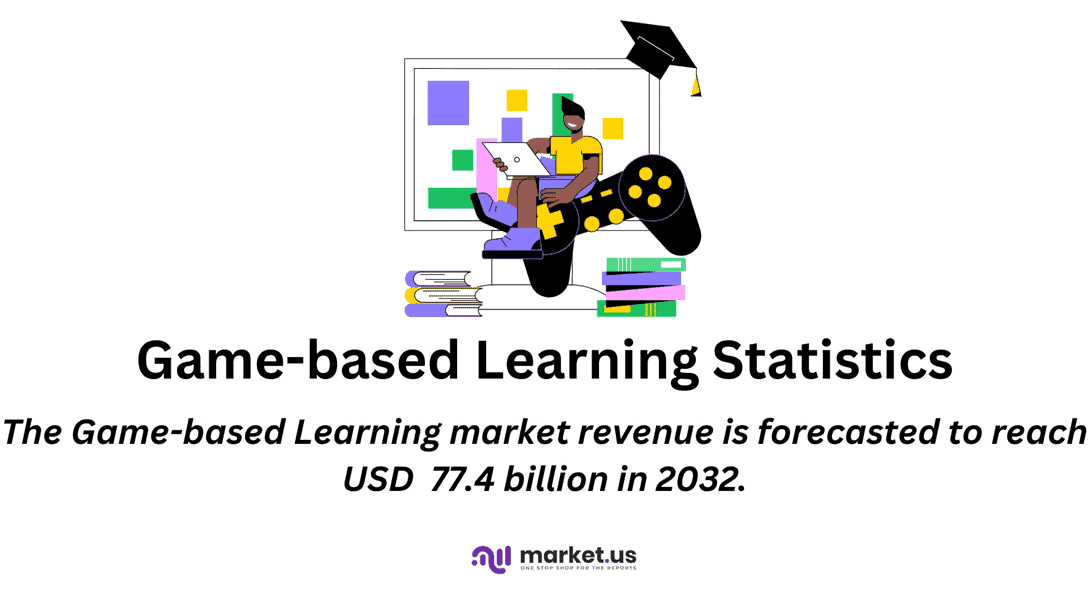
Editor’s Choice
- The game-based learning market is showing remarkable growth at a CAGR of 21.6% with its revenue projected to increase steadily over the next decade.
- In 2022, the market was valued at USD 11.5 billion, and it is expected to surge to USD 77.4 billion in 2032.
- Notably, the consumer sector commands the largest market share at 32%, reflecting the increasing trend of individuals turning to gamified educational applications and platforms to enhance their learning experiences.
- The game-based learning market exhibits varying degrees of adoption across different regions, with Western Europe leading the way, capturing a substantial market share of 47.2%.
- When it comes to game-based learning techniques, 24% of learners express a preference for activity-based gaming feeds, which offer an interactive and immersive learning experience.
- Notably, virtual reality-based learning games are leading the charge with an impressive growth rate of 51.9%, showcasing the increasing adoption of immersive technologies in education.
- According to survey data, a significant 88% of teachers who utilize digital games in their classrooms reported increased student engagement in learning, a vital factor in enhancing the educational experience.
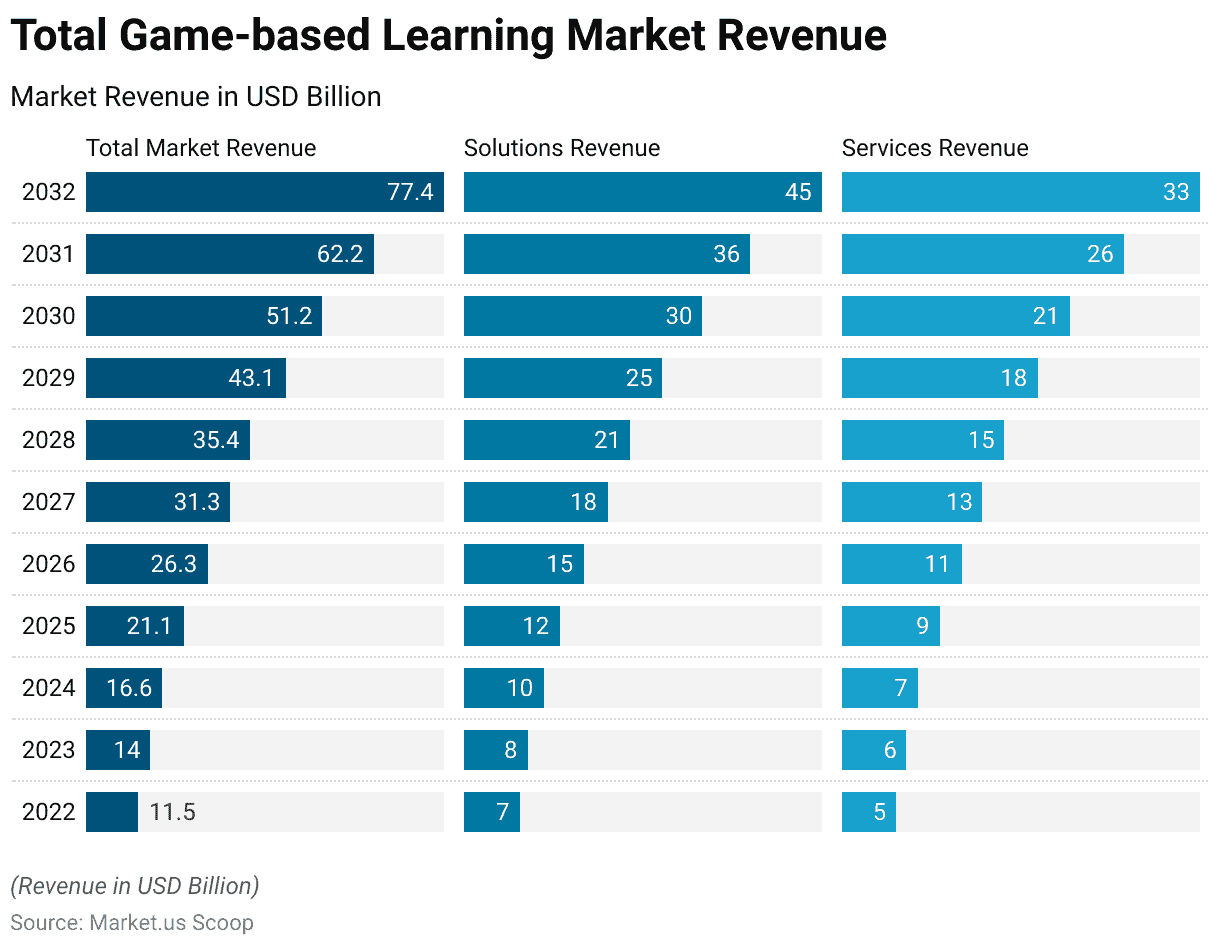
Game-based Learning Market Statistics
Global Game-based Learning Market Size
- The game-based learning market is showing remarkable growth at a CAGR of 21.6% with its revenue projected to increase steadily over the next decade.
- In 2022, the market was valued at USD 11.5 billion, and it is expected to surge to USD 14.0 billion in 2023.
- The momentum continues as we move into the future, with estimates of USD 16.6 billion in 2024 and USD 21.1 billion in 2025.
- By 2026, the market is predicted to reach USD 26.3 billion, and by 2027, it is expected to surpass USD 31.3 billion.
- This growth trend is set to accelerate further, reaching USD 35.4 billion in 2028, USD 43.1 billion in 2029, and an impressive USD 51.2 billion in 2030.
- Looking even further ahead, the game-based learning market is forecasted to reach USD 62.2 billion in 2031 and an impressive USD 77.4 billion in 2032.
- These numbers underscore the increasing importance of game-based learning in educational and training contexts, highlighting its potential to reshape the future of learning methodologies.
(Source: Market.us)
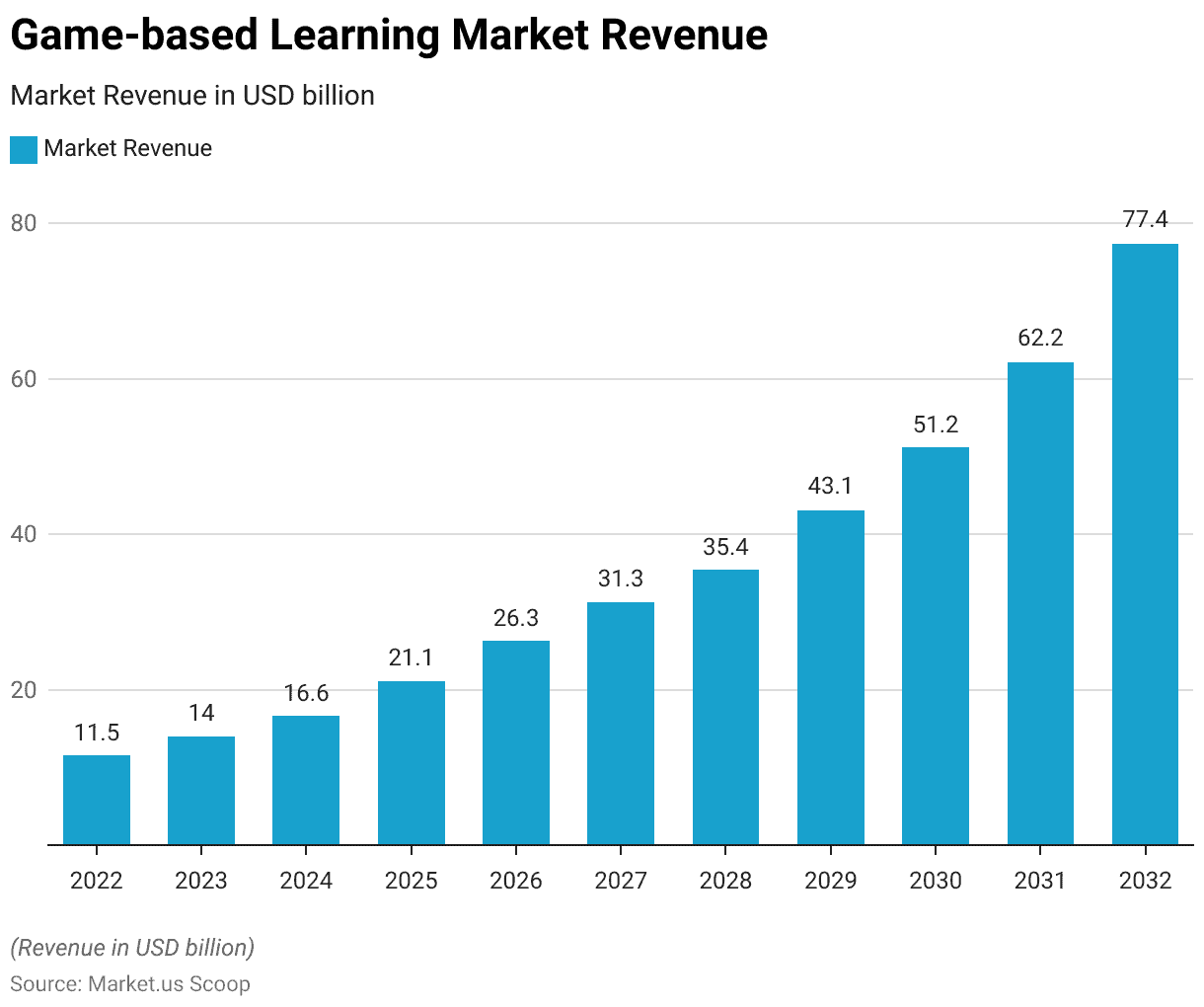
Game-based Learning Market Size – By Component
- The global game-based learning market is experiencing significant growth, with total market revenue projected to increase steadily over the coming years.
- In 2022, the market generated a total revenue of USD 11.5 billion, with solutions accounting for USD 7.0 billion and services contributing USD 5.0 billion.
- This growth trend is expected to continue, with the market revenue reaching USD 14.0 billion in 2023, USD 16.6 billion in 2024, and USD 21.1 billion in 2025.
- The rise in the adoption of game-based learning solutions is driving this expansion, as organizations recognize the effectiveness of these tools in enhancing education and training.
- By 2032, the game-based learning market is projected to reach an impressive USD 77.4 billion in total revenue, with solutions accounting for USD 45.0 billion and services generating USD 33.0 billion.
- This substantial growth underscores the increasing importance of game-based learning in educational and corporate settings, offering innovative and engaging ways to impart knowledge and skills.
(Source: Market.us)
Take advantage of our unbeatable offer - buy now!

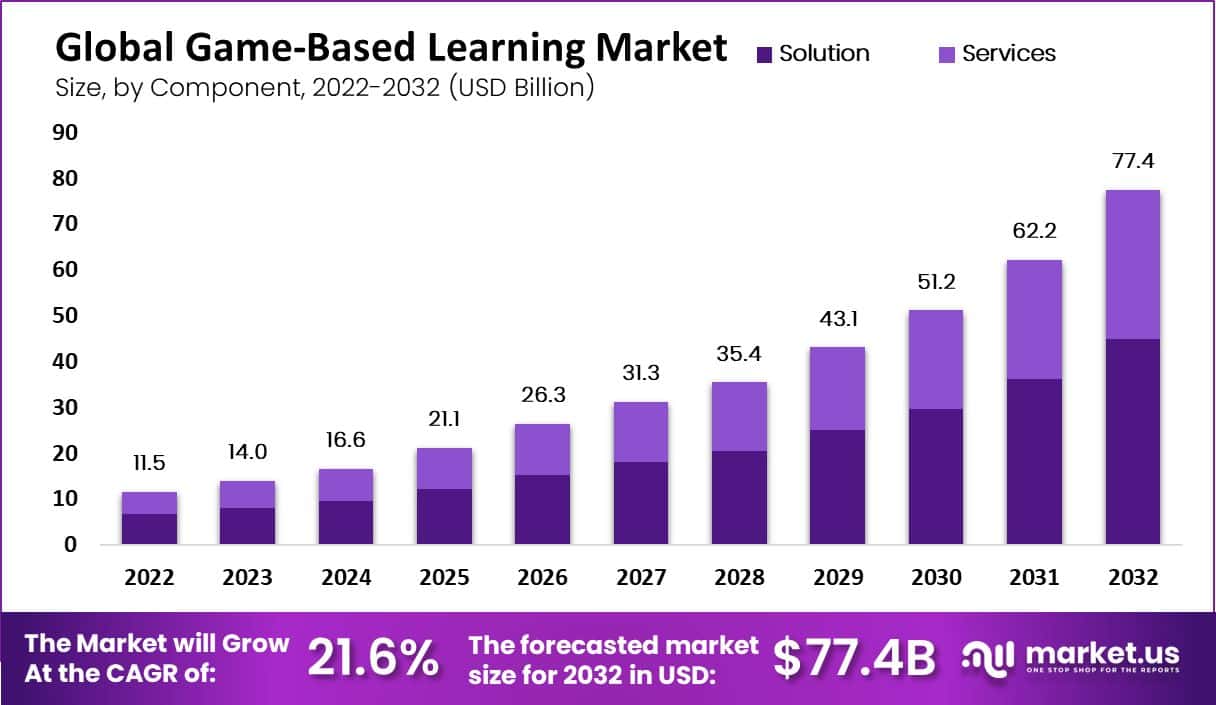
Global Game-based Learning Market Share – By End-User
- The global game-based learning market is characterized by a diverse landscape of end-user segments, each contributing to its overall dynamics.
- Notably, the consumer sector commands the largest market share at 32%, reflecting the increasing trend of individuals turning to gamified educational applications and platforms to enhance their learning experiences.
- In the education sector, game-based learning has gained significant prominence, claiming a substantial 27% market share as educational institutions and schools continue to embrace interactive gaming as a valuable teaching tool.
- Government entities, recognizing the potential of digital learning tools, contribute 11% to the market share, while enterprises, acknowledging the benefits of game-based learning for employee training and development, hold a significant 18% share.
- The remaining 12% is attributed to various other sectors, indicating the widespread adoption and versatile applications of game-based learning across multiple industries.
- This distribution underscores the broad and evolving impact of game-based learning across the global landscape.
(Source: Market.us)
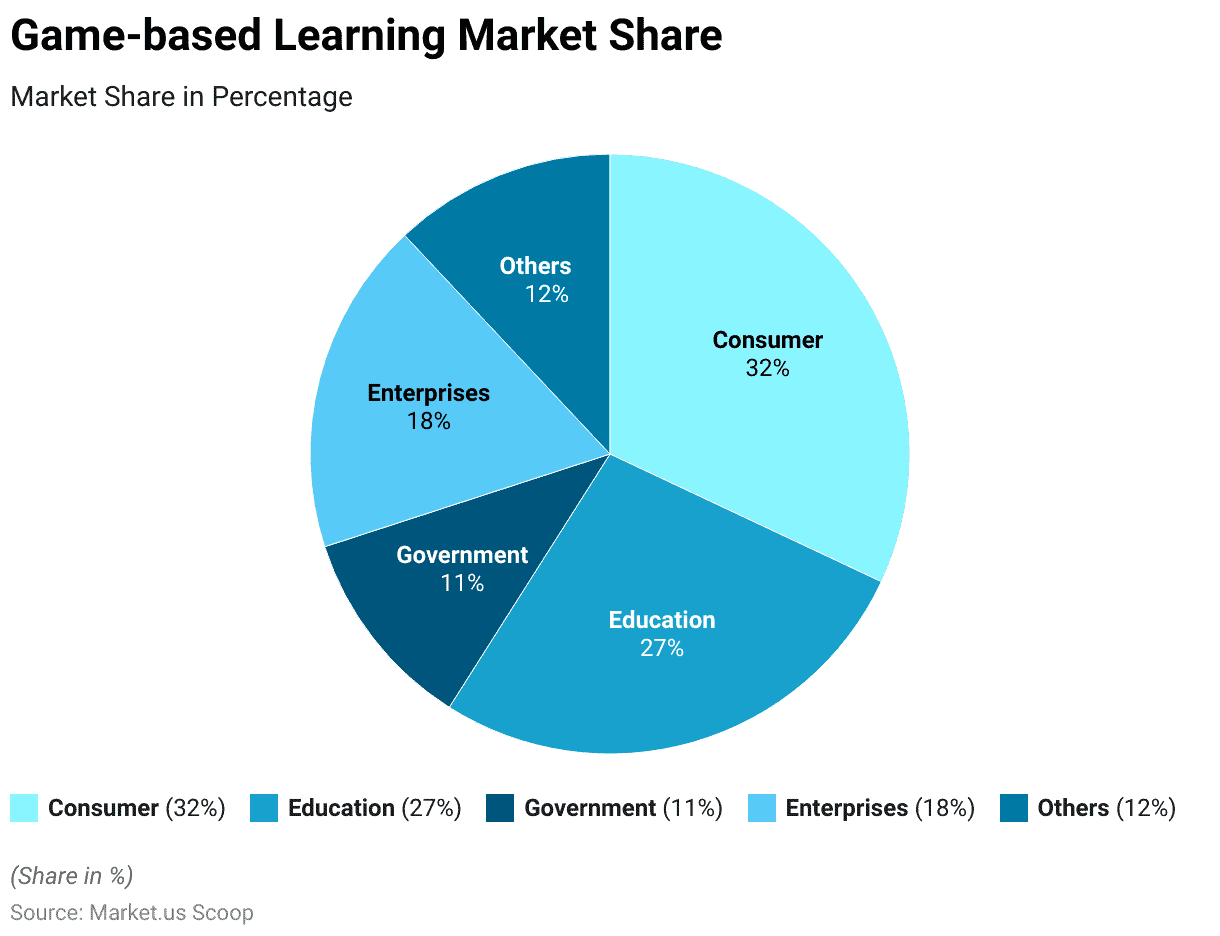
Regional Analysis of Game-based Learning Market
- The game-based learning market exhibits varying degrees of adoption across different regions, with Western Europe leading the way, capturing a substantial market share of 47.2%.
- Eastern Europe closely follows, with a significant share of 42.2%, demonstrating the growing interest in game-based educational approaches in these European regions.
- Africa and the Middle East also display strong enthusiasm for game-based learning, with market shares of 41.3% and 36.2%, respectively.
- North America and Latin America, while somewhat lower, are still actively engaging in this educational trend, contributing 35.2% and 30.1% to the market, respectively.
- In the dynamic Asia-Pacific region, game-based learning holds a market share of 27%, indicating a growing interest in leveraging gamification for education.
- These regional variations highlight the global appeal of game-based learning while emphasizing the need for tailored approaches to accommodate diverse cultural and educational contexts.
(Source: Metaari)
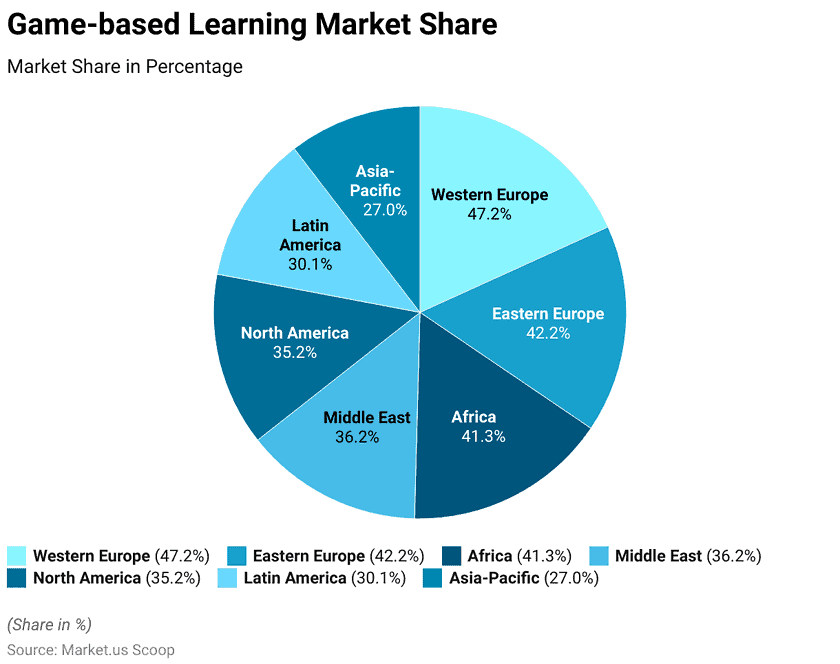
User Preferences in Game-based Learning Statistics
Most Preferred Game-Based Learning Techniques
- When it comes to game-based learning techniques, there is a notable variation in learner preferences.
- Among these techniques, 24% of learners express a preference for activity-based gaming feeds, which offer an interactive and immersive learning experience.
- Progress bars, tracking learners’ advancement, are favored by 25% of individuals, providing a sense of accomplishment and motivation.
- Instant performance feedback, with 26% of learners in favor, is highly valued for its timely guidance and assessment.
- Point scores, chosen by 27% of learners, introduce an element of competition and achievement recognition.
- The most preferred technique appears to be level-based progression, with 30% of learners opting for this structured approach that allows for gradual skill development and a sense of mastery.
- These preferences highlight the importance of catering to diverse learning styles and preferences in the realm of game-based learning.
(Source: Raccoon Gang)
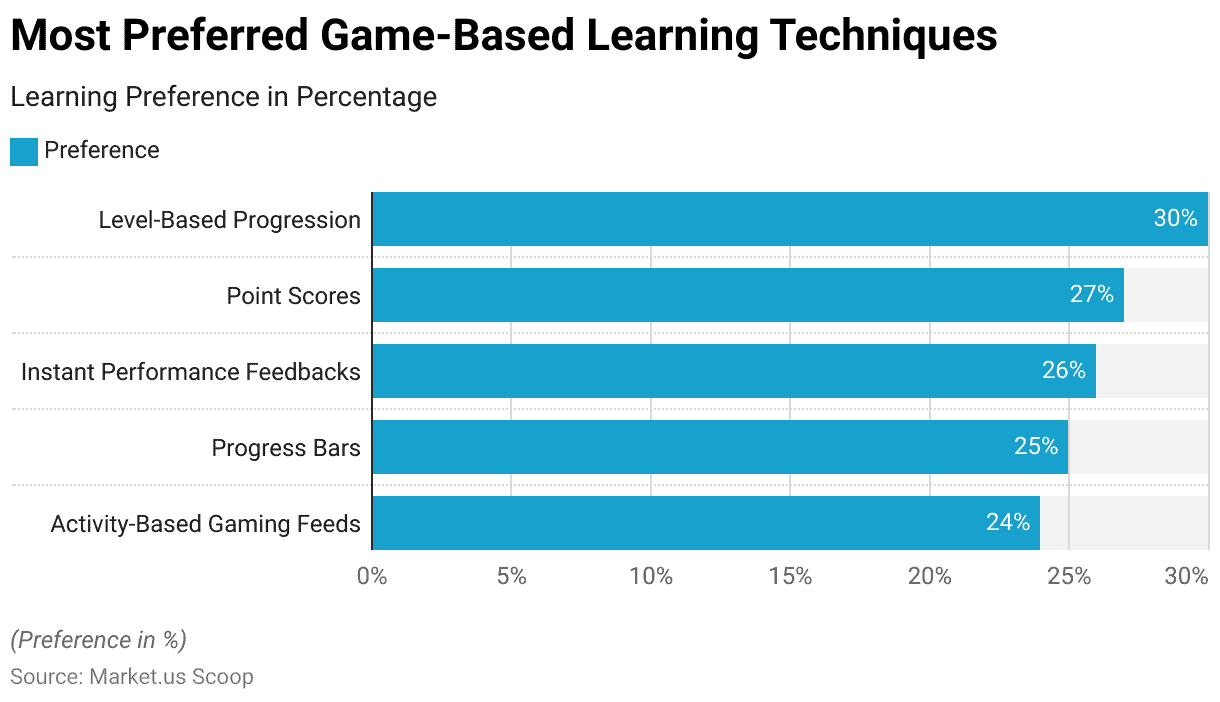
Trends Have Been Receiving a Significant Dislike from The Learners
- In the realm of game-based learning, several trends have garnered notable disapproval from learners.
- A mere 2% of users express their dissatisfaction with the use of virtual currencies, which may introduce complexities or distractions in the learning experience.
- Slightly higher, 3% oppose the presence of avatars, potentially finding them distracting or unrelated to the learning objectives.
- A more significant 11% of learners disapprove of the use of story-based scenarios, suggesting a preference for alternative teaching methods.
- Virtual gifts, disliked by 12% of users, may be perceived as extraneous or not aligned with the educational goals.
- Lastly, 13% of learners deprecate the idea of competing with friends, indicating a desire for a more individualized or collaborative learning experience.
- These dislikes underscore the importance of tailoring game-based learning experiences to align with diverse learner preferences and needs.
(Source: Raccoon Gang)
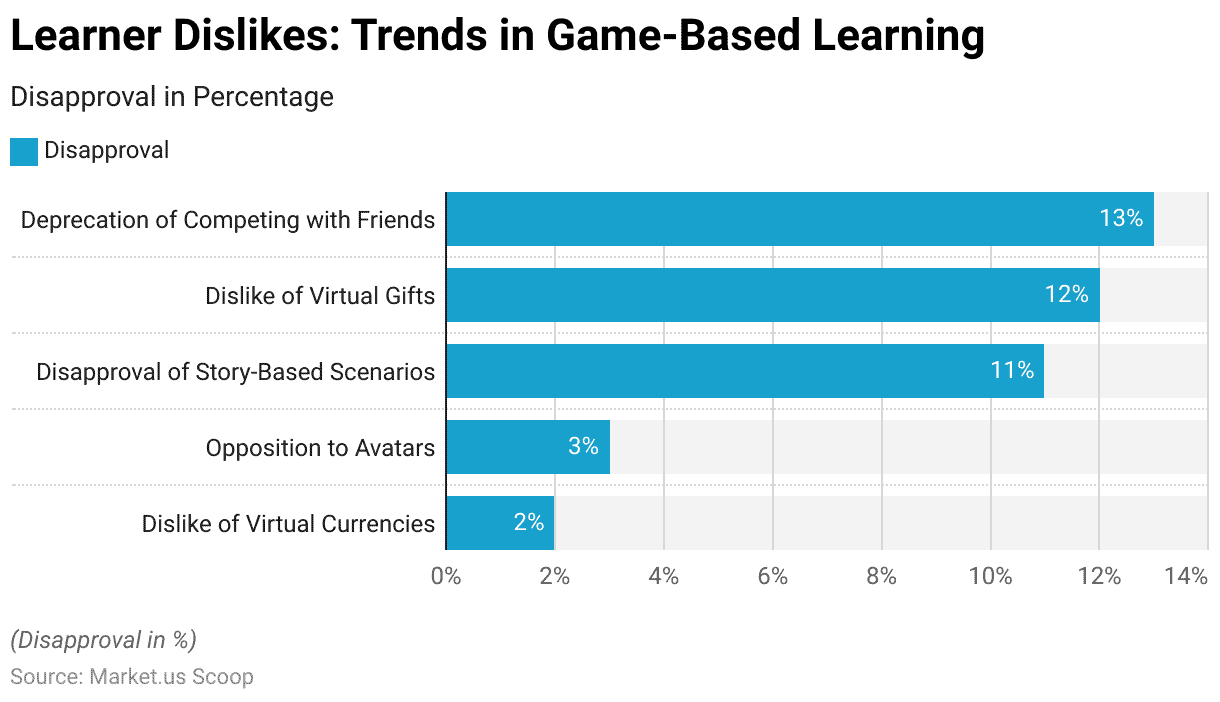
Growth Rate of Educational-type Games
- The growth rate of educational-type games reflects the evolving landscape of digital learning.
- Notably, virtual reality-based learning games are leading the charge with an impressive growth rate of 51.9%, showcasing the increasing adoption of immersive technologies in education.
- Evaluation and assessment games are also on the rise, experiencing a substantial growth rate of 46.2%, underscoring the importance of effective assessment tools in the learning process.
- Language learning games, with a growth rate of 41.8%, are another significant player, highlighting the demand for interactive language acquisition methods.
- These growth rates collectively illustrate the dynamic nature of educational gaming, with a strong emphasis on technology-driven and assessment-focused approaches, as well as the enduring popularity of language learning through gamification in the education sector.
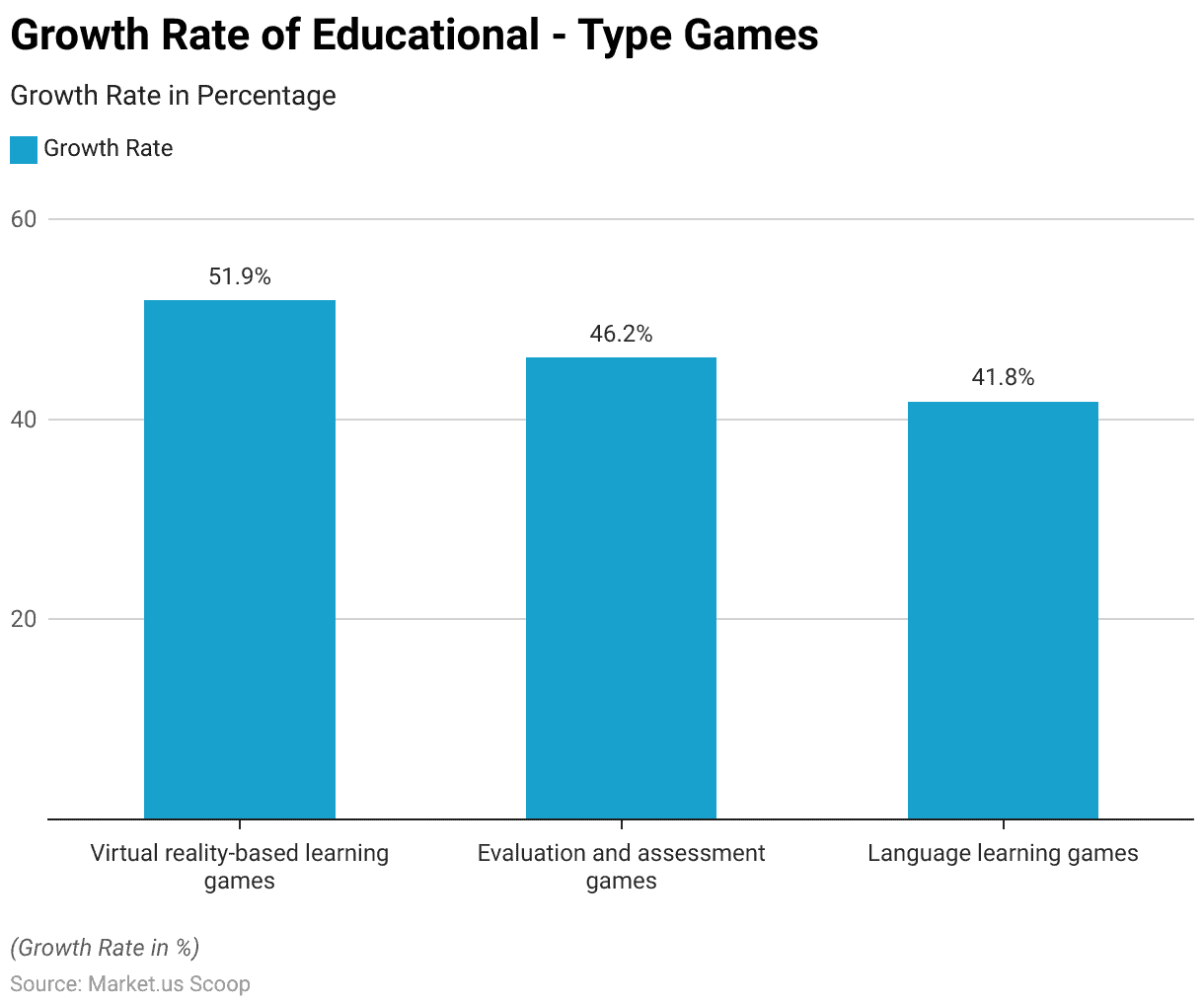
Game-based Learning in Education Statistics
- These game-based learning statistics provide valuable insights into the evolving landscape of education.
- It’s promising to see that 74% of teachers are embracing digital game-based learning to enrich their lessons, indicating a growing recognition of its educational value.
- The fact that 93% of class time is effectively utilized during game-based learning sessions highlights the engagement and focus it can foster among students.
- Moreover, the involvement of 52% of young students in educational games demonstrates the appeal of this approach among the next generation of learners, especially considering that 91% of school-age children are already familiar with video games.
- These statistics collectively emphasize the relevance and potential of game-based learning in modern classrooms.
- However, challenges persist, as only 46% of children have access to the necessary technology for video game-based learning, posing hurdles to its widespread implementation.
- Nonetheless, a significant 54% of U.S. educators strongly believe that game-based learning is indispensable, with an additional 38% agreeing on its necessity in the classroom.
- This broad consensus underscores the perceived value of this approach in enhancing the learning experience.
- Interestingly, only a small fraction, 8%, of U.S. instructors remain uncertain about its necessity, indicating a relatively low level of skepticism.
- In conclusion, these statistics reflect the growing acceptance and potential of game-based learning, albeit with some practical challenges to address.
(Source: Prodigy Math Blog, EDTech)
Game-based Learning in K-12 Education
- A research study involving 105 preschoolers has revealed that those who were exposed to an interactive game-based learning approach that included gestures showed improved learning performance and motor skills.
- In Malaysia, five preschoolers expressed their enjoyment of using an interactive AR alphabet book, while eight students strongly indicated their preference for it.
- Six children from the study expressed their willingness to participate in the game again, and nine strongly agreed that they wanted to take part once more.
- Furthermore, the introduction of interactive teaching techniques to both 8th and 4th-grade students resulted in positive outcomes.
- The combined effect size for studies that integrated both online and in-person learning was +0.35, signifying a statistically significant advantage for the blended approach compared to either exclusive in-person or online learning.
- In the academic year 2015-2016, roughly 5 million K-12 Education students actively participated in online or virtual classes.
(Source: Science Direct, ED Policy, US Department of Education)
Work Setting Game-based Learning Statistics
- In the workplace, the adoption of game-based learning has seen a remarkable compound annual growth rate of 53.4%. This substantial growth underscores the increasing recognition of the effectiveness of gamified approaches in enhancing employee training and development.
- Research findings have shown that the integration of microlearning techniques has led to a significant improvement in learners’ performance, with a notable increase of 17%.
- Moreover, it has contributed to a 50% boost in engagement rates, highlighting the impact of bite-sized, focused learning modules on employee participation and knowledge retention.
- In the realm of military training, the Pentagon’s investment of $479 million in a Microsoft contract for Virtual Reality (VR), Augmented Reality (AR), and Artificial Intelligence (AI) technology is a clear indication of the growing importance of immersive and advanced technologies in soldier training.
- Such investments signify a commitment to harnessing cutting-edge tools to better prepare military personnel for their roles.
- Additionally, in the corporate world, a remarkable 82% of companies currently implementing AR and VR technologies report that the benefits they are experiencing meet or even exceed their initial expectations.
- This high level of satisfaction suggests that these emerging technologies are delivering tangible advantages, such as improved training outcomes, cost savings, and enhanced employee performance, in alignment with organizational objectives.
(Source: ELearning Industry, Forbes)
Benefits of Using Digital Games Within Learning
- The integration of digital games into the elearning process offers a range of compelling benefits for both teachers and students.
- According to survey data, a significant 88% of teachers who utilize digital games in their classrooms reported increased student engagement in learning, a vital factor in enhancing the educational experience.
- These games also excel in addressing diverse learning styles, with 80% of these educators noting their effectiveness in catering to varied student needs.
- Additionally, they serve as valuable tools for reinforcing learning, as reported by 62% of teachers, and provide essential practice opportunities for 59% of students.
- Furthermore, digital games enable teachers to differentiate instruction, making it more personalized and effective, a feature appreciated by 59% of educators.
- These games also help students visualize complex concepts (51%) and introduce new ideas within lessons (50%), making them versatile and valuable assets in the modern educational landscape.
- Overall, digital games emerge as powerful tools that promote engagement, adaptability, and enhanced learning experiences in the classroom.
(Source: BrainPOP)
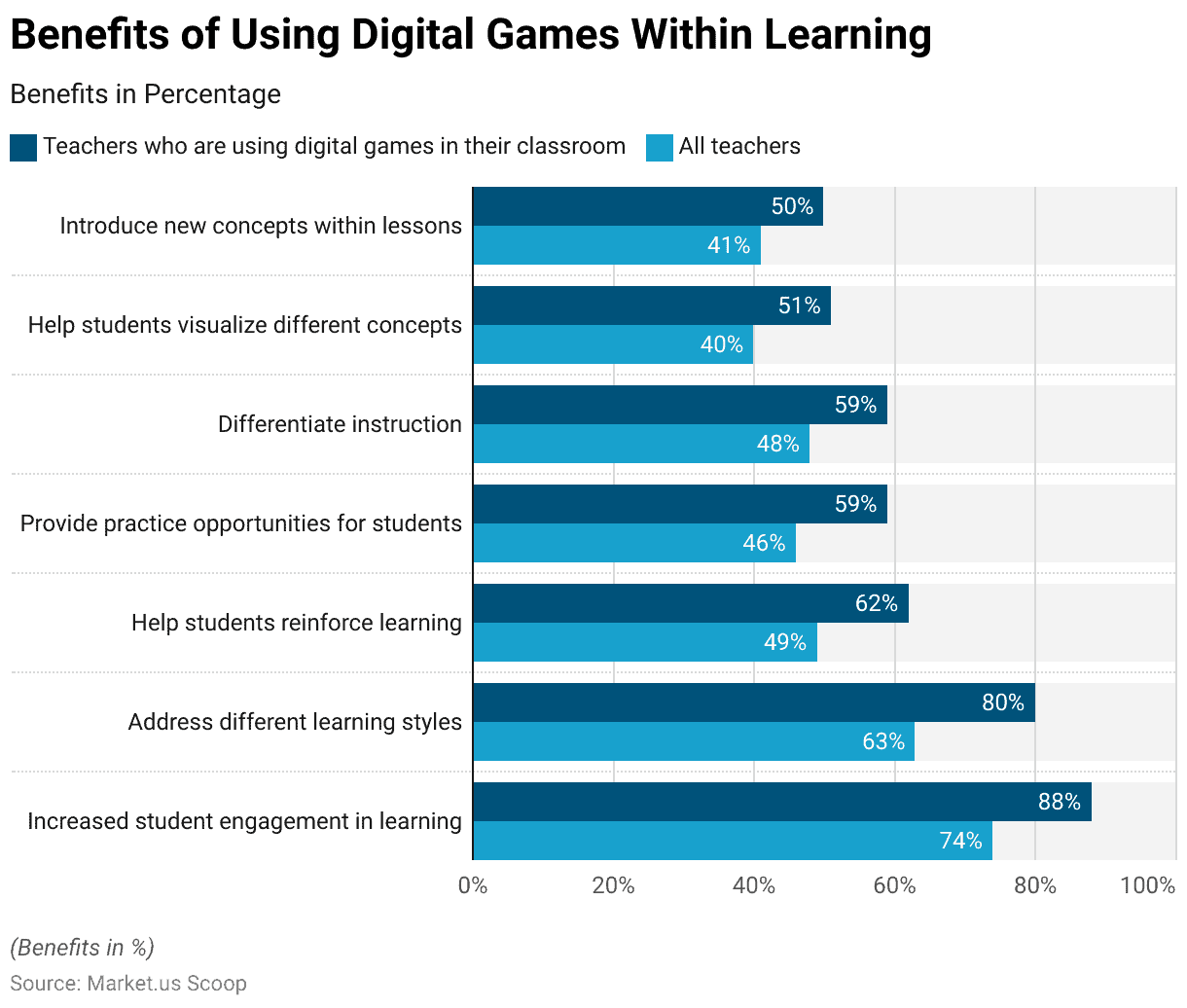
Recent Developments
Acquisitions and Mergers:
- Kahoot! acquires Clever: In 2023, Kahoot!, a leading game-based learning platform, acquired Clever, a U.S. educational technology company, for $500 million. This acquisition strengthens Kahoot!’s presence in the U.S. market and enhances its ability to integrate game-based learning into classrooms through Clever’s extensive platform.
- BYJU’s acquires Tynker: In 2023, Indian edtech giant BYJU’s acquired Tynker, a game-based coding platform for kids, in a deal worth $200 million. This acquisition aims to expand BYJU’s global footprint in the game-based learning space, focusing on coding and STEM education.
New Product Launches:
- Minecraft Education Edition introduces new learning modules: In early 2024, Minecraft Education Edition launched new learning modules focused on STEM, history, and language arts. These modules use Minecraft’s game-based learning approach to engage students in creative problem-solving and teamwork.
- Duolingo expands gamification features: In late 2023, Duolingo added more interactive game-based features, including new rewards systems and social challenges, to further engage users in learning new languages. These updates are designed to increase retention and encourage regular usage through playful competition.
Funding:
- Dreamscape Learn secures $30 million for immersive learning: In 2023, Dreamscape Learn, a company specializing in immersive, game-based education, raised $30 million in Series B funding. The funds will be used to expand their VR-based learning platform, which combines narrative-driven gaming experiences with educational content.
- Quizizz raises $31.5 million to boost game-based learning: In 2024, Quizizz, a platform that turns quizzes into engaging, interactive games, secured $31.5 million in funding to expand its content and further develop its game-based learning tools for K-12 students worldwide.
Technological Advancements:
- AI integration in game-based learning platforms: Game-based learning platforms are increasingly integrating AI to provide personalized learning experiences. By 2025, over 40% of game-based learning tools will utilize AI to adapt content to individual learners’ needs, making education more engaging and effective.
- VR and AR in education: Virtual reality (VR) and augmented reality (AR) are becoming more prominent in game-based learning, allowing for immersive educational experiences. By 2026, VR and AR are projected to account for 30% of the game-based learning market, as schools and universities adopt these technologies for hands-on learning.
Conclusion
Game-based Learning Statistics – In conclusion, game-based learning has become a widely recognized and effective approach in education, offering engaging and tailored learning experiences across various age groups and educational levels.
Its steady market growth and strong learner preferences for specific techniques highlight its increasing importance.
However, challenges like technology access disparities and varying educator acceptance persist. Nonetheless, the incorporation of emerging technologies like virtual and augmented reality holds promise for even more immersive educational experiences.
Game-based learning represents an exciting frontier in education, fostering engagement and enhancing learning outcomes, with a bright future ahead.
FAQs
Game-based learning is an educational approach that uses games, simulations, and interactive activities to engage learners, enhance their understanding of concepts, and achieve specific learning objectives. It leverages game mechanics to make learning enjoyable and effective.
Game-based learning can benefit students by increasing engagement, improving retention of information, promoting problem-solving and critical thinking skills, and catering to different learning styles. It can also make learning more enjoyable and motivating.
Game-based learning can be adapted for learners of all ages, from preschoolers to adults. Different games and approaches are designed for specific age groups and educational levels.
Yes, there are various types of game-based learning, including digital games, board games, card games, and simulations. It can also be categorized into serious games (designed for educational purposes) and gamification (adding game elements to non-game contexts).
Yes, game-based learning can be integrated into traditional classrooms as part of the curriculum. Teachers can use educational games to supplement lessons, reinforce concepts, and engage students in interactive learning experiences.
Discuss your needs with our analyst
Please share your requirements with more details so our analyst can check if they can solve your problem(s)



